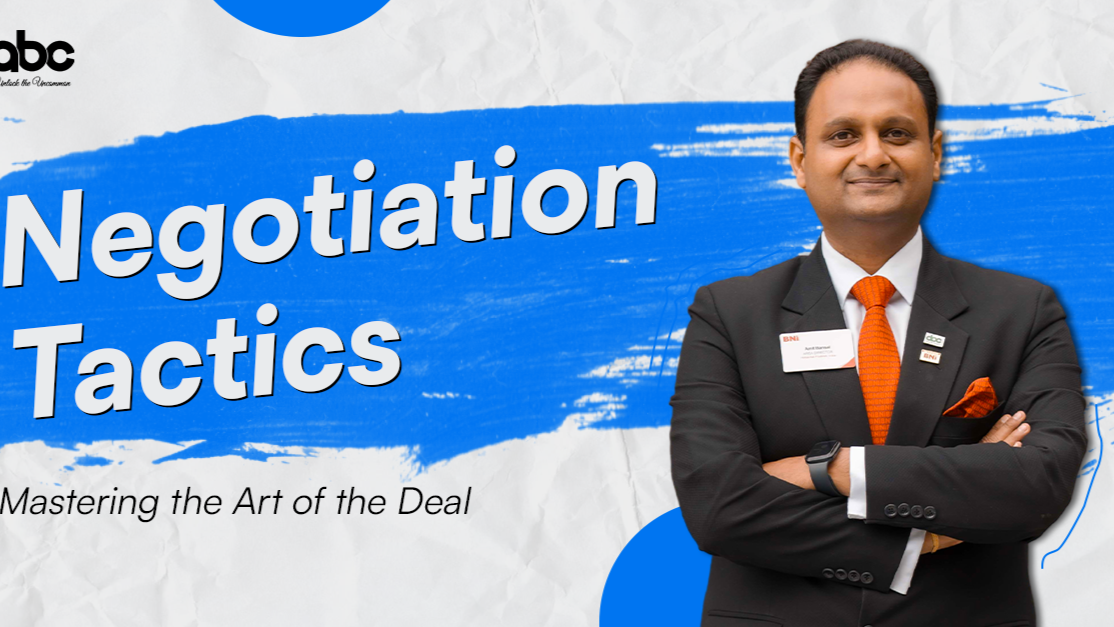
Negotiation Tactics: Mastering the Art of the Deal?
???????? ????????????
Business Coach | Corporate Trainer | ICF Certified | ActionCOACH Owner | Startup Mentor | Amazon Bestselling Author | Public Speaking Expert | Leadership & Business Growth | 630+ Trainings Delivered
Negotiation is an essential skill that can significantly impact both your personal and professional life. Whether you're negotiating a salary, a contract, or even just trying to reach an agreement with a friend, understanding effective negotiation tactics can make all the difference. This guide will delve into various strategies and techniques to help you master the art of negotiation.
1. Understanding the Basics of Negotiation
Before diving into tactics, it’s crucial to grasp what negotiation is all about. At its core, negotiation is a dialogue between two or more parties aimed at reaching an agreement. Understanding the interests and needs of both parties is vital for successful negotiations.
2. The Importance of Preparation
Preparation is key to successful negotiations. Here’s how to prepare effectively:
2.1 Research Your Counterpart
Gather information about the person or organization you’re negotiating with. Understand their goals, needs, and past negotiation styles. This insight will allow you to anticipate their moves.
2.2 Define Your Goals
What do you want to achieve? Set clear objectives and know your limits. This clarity will guide your negotiation strategy.
2.3 Develop a BATNA
Your Best Alternative to a Negotiated Agreement (BATNA) is your backup plan. Knowing your BATNA gives you leverage and confidence during negotiations.
3. Effective Communication Skills
3.1 Active Listening
Listening is just as important as speaking in negotiations. Show that you value the other party's perspective by practicing active listening. This technique fosters trust and opens doors for compromise.
3.2 Clear Articulation
Be clear and concise in expressing your needs and proposals. Avoid jargon and be straightforward to minimize misunderstandings.
4. Building Rapport
Building rapport can significantly influence the negotiation outcome. Here’s how to establish a connection:
4.1 Find Common Ground
Identify shared interests or experiences to create a sense of camaraderie. This connection can make the negotiation process smoother.
4.2 Use Empathy
Show genuine concern for the other party’s needs and feelings. Empathy can create a positive atmosphere that encourages collaboration.
5. Employing Tactical Approaches
5.1 The Anchoring Technique
Start with an initial offer that sets the tone for the negotiation. This “anchor” can influence the perceived value of subsequent offers.
5.2 The Win-Win Approach
Strive for solutions that benefit both parties. This approach fosters long-term relationships and trust, making future negotiations easier.
5.3 Leverage Silence
Silence can be a powerful negotiation tactic. After making a proposal, allow for silence. It creates tension that may prompt the other party to respond more favorably.
6. Overcoming Objections
Objections are common in negotiations. Here’s how to handle them:
6.1 Acknowledge Concerns
Don’t dismiss objections. Acknowledge them, and show that you understand the other party's position.
6.2 Provide Solutions
Counter objections with well-thought-out solutions. Demonstrating that you've considered their concerns can help move negotiations forward.
7. Closing the Deal
Closing a negotiation effectively is crucial. Here are some strategies:
7.1 Summarize Key Points
Before finalizing, recap the main points discussed. This ensures clarity and agreement on both sides.
7.2 Create a Sense of Urgency
Encourage timely decision-making by introducing deadlines or limited-time offers. This tactic can prompt quicker resolutions.
8. The Art of Compromise
Compromise is often necessary for successful negotiations. Here’s how to approach it:
8.1 Identify Non-Essentials
Know which points you're willing to concede. This flexibility can lead to a favorable outcome.
8.2 Seek Creative Solutions
Think outside the box to find alternatives that satisfy both parties’ needs.
9. Learning from Experience
9.1 Reflect on Past Negotiations
After a negotiation, take time to reflect on what worked and what didn’t. This practice will enhance your skills for future negotiations.
9.2 Continuous Improvement
Negotiate whenever possible, even in low-stakes situations. The more you practice, the more skilled you’ll become.
10. Conclusion
Mastering negotiation tactics takes time, practice, and patience. By understanding the basics, preparing thoroughly, communicating effectively, and employing tactical approaches, you can become a skilled negotiator. Remember, negotiation is not just about getting what you want; it’s about finding solutions that benefit everyone involved.